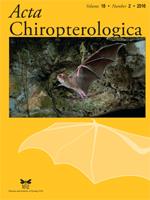Among the many anthropogenic modifications to earth's ecosystems, habitat loss and degradation pose the most immediate threat to many biota. The predicted consequences of fragmented habitats include lower species diversity, smaller population sizes, disrupted gene flow, increased drift and inbreeding and increased differentiation between neighbouring populations; all of which are thought to be further enhanced in species with low dispersal abilities. These factors, especially when occurring in tandem, can lead to an increased risk of extinction. To examine the genetic consequences of habitat fragmentation we selected an isolated population of a sedentary woodland specialist species (Rhinolophus hipposideros) to act as an indicator of disruptions to landscape level connectivity. Based on 491 individuals from 37 colonies our results revealed the presence of a broad North-Range/South-Range differentiation within this species in Ireland; a finding supported across datasets (mtDNA and nuclear microsatellites) and analyses. Analyses of echolocation data and microsatellites suggested further differentiation of the northern-most colonies. A landscape genetics framework to assess the impact of habitat versus geographic distance on population differentiation showed that habitat features (at a five km resolution) were equally likely to be correlated with differentiation as geographic distance considered alone. Further differentiation of the geographically disjunct groups is likely to occur in the future. The viability of either group alone is uncertain given their restricted distribution, small population sizes (based on census data and Ne estimates) and isolation. Roost provision and habitat restoration in the geographic region separating the differentiated groups will be fundamental to the recolonization of this area and the reestablishment of connectivity between the regional groups.
How to translate text using browser tools
1 December 2016
The Effects of Human-Mediated Habitat Fragmentation on a Sedentary Woodland-Associated Species (Rhinolophus hipposideros) at Its Range Margin
Serena E. Dool,
Sébastien J. Puechmaille,
Conor Kelleher,
Kate McAney,
Emma C. Teeling
ACCESS THE FULL ARTICLE

Acta Chiropterologica
Vol. 18 • No. 2
December 2016
Vol. 18 • No. 2
December 2016
Anthropocene
connectivity
conservation
extinction risk
landscape genetics
population decline
Rhinolophus hipposideros




